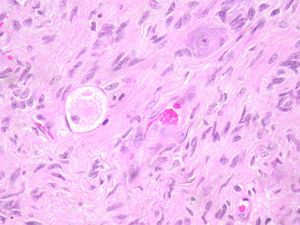Category:Obstruction, Intestinal
Jump to navigation
Jump to search
Intestinal obstruction can be the sequel to either mechanical or functional causes. Mechanical obstruction occurs due to physical blockage of the intestinal lumen whereas functional obstruction results from a decrease or inhibition of intestinal motility due to loss of smooth muscle contraction (Brown et. al, 2007).
Category:Intestine - Mechanical Obstruction
Functional Obstruction
Paralytic Ileus
- A common condition.
- Occurs following trauma or abdominal surgery.
- Stasis of gut flow due to failure of peristalsis.
- Leads to distension with gas and fluid, as well as a flaccid intestinal wall.
Causes
- Anything which stops peristalsis, e.g.
- Damage to nerve supply to intestine (autonomic nervous system)
- Pain
- Abnormal metabolism
- Toxaemia
- Electrolyte imbalance such as hypocalcaemia, hypomagnesaemia, and hypokalaemia.
- Also in
- Diabetes mellitus
- Uraemia
- Tetanus
- Lead poisoning.
Pathology
- loss of smooth muscle tone leads to a flaccid bowel.
- Bowel is distended with fluid.
Pathogenesis
- Intestine susceptible to neurogenic damage during an operation.
- Peristalsis fades away over a few days producing paralytic (adynamic) ileus.
- Particularly occurs if bowel handled roughly, or if serosa gets cold and dry at surgery.
- Very difficult to start peristalsis again but will sometimes respond to pharmacological or electrical stimulation.
- The horse is very susceptible, and the dog is somewhat suscpeitble.
Dysautonomia
- Most notably affects horses and cats.
Equine dysautonomia, or grass sickness
- Most prevalent in the UK and western Europe.
- Common in wetter areas, e.g. the South West.
- Seen in horses out at pasture in late summer and autumn.
- Usually affects young adults.
- 6-7 years old.
- Clinical
- Acute oneset:
- Muscular tremors
- Abdominal pain
- Does not eat
- Constipation
- Become severly tympanic in acute cases
- Dull and restless
- Avoid swallowing
- Salivate excessively
- Degenerative lesions are seen in the autonomic nerve ganglia, including enteric plexuses
- May either:
- Progress rapidly to death
- Take a slower clinical course.
- Eat a bit, but food drops out of mouth
- Go on to die slowly.
- Some horses recover
- This is very unlikely, and the condition is usually fatal.
- Clinically difficult to diagnose - signs are confined to the gut.
- Easy to diagnose on post mortem
- Acute oneset:
- Pathology
- Stomach and small intestine large amounts of contain watery yellow fluid.
- There is an abrupt change in the large intestine, where no fluid is present.
- large intestine has very dry mucoid contents.
- There is an abrupt change in the large intestine, where no fluid is present.
- Stomach and small intestine large amounts of contain watery yellow fluid.
- Pathogenesis
- Due to functional obstruction at ileocaecal valve and a degree of paralytic ileus of the small intestine.
- The exact cause is unknown, but a type of bacterial or fungal toxin which may damage autonomic nervous system ganglia may be involved.
- Clostridium botulinum is thought to be involved.
- A similar condition seen in hares
- Certain yeares almost seem to have outbreaks.
- Certain pastures at certain times of year produce grass sickness quite often.
- A definitive diagnosis must be made - if the condition is due to the grazing we need to know.
- E.g. if on livery or stud grazing, may put people off going there.
- A definitive diagnosis must be made - if the condition is due to the grazing we need to know.
- 'Diagnosis
- At post mortem look for degenerative changes in coeliaco-mesenteric ganglia - need to examine histologically.
- Ganglia are peanut sized and found in perirenal fat between adrenal gland and the aorta.
- At post mortem look for degenerative changes in coeliaco-mesenteric ganglia - need to examine histologically.
Feline dysautonomia, or Key-Gaskell Syndrome
- Occurs mostly in the UK and continental Europe.
- Is also of unknown aetiology. Suggested causative factors include:
- Environmental toxins
- Infectious agents
- Botulinum toxins .
- Clinical signs:
- Anorexia
- Depression
- Bradycardia
- Decreased lacrimation,
- Altered pupillary dilataion,
- Megaoesophagus
- Constipation.
- Degenerative lesions of autonomic nerve ganglia can be seen.
- Also occurs in the oesophagus.
Subcategories
This category has the following 2 subcategories, out of 2 total.
